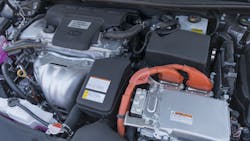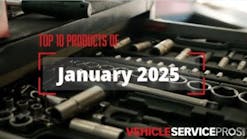With the recent focus on reducing greenhouse gas emissions and improving fuel economy for passenger cars and trucks, hybrid vehicles are becoming increasingly prevalent. The Center for Advanced Automotive Technology said that there are currently over 4 million hybrid and electric vehicles on the road in the U.S. This growing category poses a revenue opportunity for independent repair shops and technicians looking to expand their current customer base.
According to respondents to the 2017 PTEN Aftermarket Profile, only 34 percent of respondents currently complete hybrid work in their shops. The biggest barrier to collecting revenue from this repair category is training. Hybrid electric vehicles use high voltages that can cause injury if manufacturer safety procedures and general shop safety procedures are not followed. According to Fluke, a conventional vehicle’s electric system is between 12 and 14 volts, while a hybrid vehicle ranges from 12 to 650 volts. Potentially dangerous voltages exist at the high voltage cables, high-voltage batteries, capacitors and the electric motor-generators. But, if you are willing to invest in training on hybrid vehicle repair, you can offer repair services that many other repair shops do not offer.
Hybrid repair requires a few specialized tools. When selecting a digital multimeter for testing hybrid vehicles, it is important to consider the CAT rating. A higher CAT number means a tool is rated for an electrical environment with more power and energy transients, Fluke says. A digital multimeter for use on hybrid vehicles should be a CAT III or CAT IV rating of at least 1,000V.
Because hybrids use high voltages, it is important to use class “O” rubber insulating gloves with leather overprotectors when working on the high voltage systems. The rubber gloves are an important safety measure to prevent accidental electrocution, and the leather overprotectors protect the rubber gloves from damage such as punctures and cuts.
Another hybrid vehicle repair consideration is servicing the A/C system. Some hybrid vehicles have higher voltage systems that use a different oil type than traditional A/C systems, which leads to cross-contamination concerns when servicing multiple vehicles. Fortunately, there are RRR machines that work with both standard and hybrid vehicles, such as the Robinair 1234YF A/C Service Machine, which includes an integrated identifier to sample refrigerant prior to recovery.
According to Jim O’Hara, vice president of marketing at Clore Automotive, hybrids use a 12V battery in conjunction with the high voltage battery pack. “If the 12V battery is dead, the vehicle will not power up or start. Our battery chargers can be used to charge the 12V battery to keep it in optimal condition, avoiding future no-start situations.”
Repair shops should already have most or all of the battery testing equipment needed to service the 12V battery, including battery testers, battery chargers and jump starters. These are items that shops may already be using to service conventional vehicles. Notably, most hybrid vehicles utilize and AGM battery. “For shops that have not invested in AGM-compatible equipment, it is necessary to do so if they want to service hybrids,” Clore’s O’Hara says.
If shops are willing to invest in hybrid training for their technicians and a few specialized tools for hybrid vehicle repair, they will be able to expand their customer base by servicing hybrid customers that many other repair shops are not equipped to handle.



